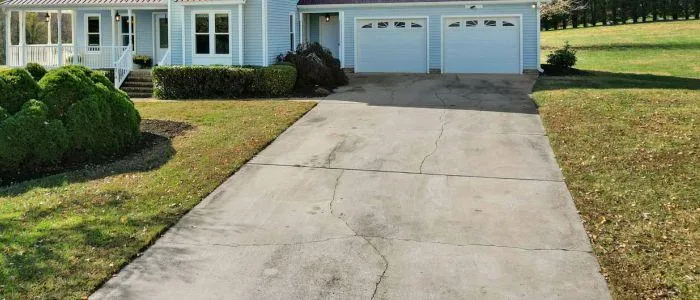
To Repair or Replace? That’s the Question…
People frequently turn to the internet with the same question about their pavement: Should I repair my asphalt or replace it entirely? The answer isn't one-size-fits-all, but you don’t need to be a paving pro to figure it out. All you need are sharp eyes and a solid sense of what to look for. Below is a simple self-diagnostic walkthrough to help you make a smart decision.
1. INSPECT SURFACE INTEGRITY
Take a good walk around your driveway or lot, ideally in daylight and after rain (so moisture shows flaws).
Look for:
Minor, isolated cracks: Think of hairline cracks or small ½-1 inch fissures. These are common and often fixable with crack sealing or rejuvenation.
Widespread cracking: Cracks forming a web or snakeskin pattern (also called alligator cracking) indicate the pavement is failing beneath the surface. Replacement is likely.
Deep potholes or surface spalling: These are signs of structural issues and typically require replacement.
Quick rule: Small, scattered issues = repair; networked cracks and heavy damage = replacement.
2. MEASURE THE COVERAGE OF PROBLEMS
Next, mentally divide your surface into quarters.
If less than 25% of the area has noticeable issues, cracks, fading, or isolated potholes, repair is usually sufficient. If more than 25% of the material is deteriorated or compromised, replacement becomes more cost-effective in the long run.
3. ASSESS PAVEMENT AGE
Asphalt longevity hinges on care. If your pavement is under 15 years old and generally well-maintained, repairs (sealing cracks, patching, rejuvenation) often restore life effectively.
If it's 20+ years old, especially without regular maintenance, replacement may be the smarter financial move.
4. EVALUATE COMPACTION & DRAINAGE
Look for telltale signs of settling or poor drainage. Water pooling, gutter crumbling, or sections that slope improperly are warnings. Even a freshly paved surface can fail fast if drainage issues persist. These weak areas often demand replacement first—or a full reconstruction to fix the foundation.
5. THINK PAVEMENT PURPOSE
Consider what the asphalt bears every day: Driveways with passenger vehicles aren’t as demanding. Parking lots with heavier traffic or trucks need stronger, thicker pavement. If your pavement isn't up to the job, replacement with proper base prep becomes essential.
Quick Comparison Table
What You Can Do Right Now
Walk the lot and spot damage.
Estimate coverage: Less or more than 25%?
Note age and upkeep history.
Observe water behavior. Does it pool?
Think traffic: Cars or trucks?
If your assessment leans toward repair, crack sealing or asphalt rejuvenation can often significantly extend life and save money. But if it’s pointing to structural failure, an expert replacement might be the real value play.
Our Two Cents (Based on 15+ Years of Experience)
We’ve been evaluating and installing asphalt for over 15 years. Our rule? A well-maintained repair for early issues saves money. But once damage is widespread or structural, a precise replacement with proper grading and drainage is the better investment.
Not sure what direction is best? We offer free on-site estimates and honest advice to help you make the right call for your budget and timeline.
We’re looking forward to helping you make the right call! If you’re interested in using BlakRoc for your paving or maintenance needs, contact us. If you haven’t already follow us on Instagram for more asphalt content!




